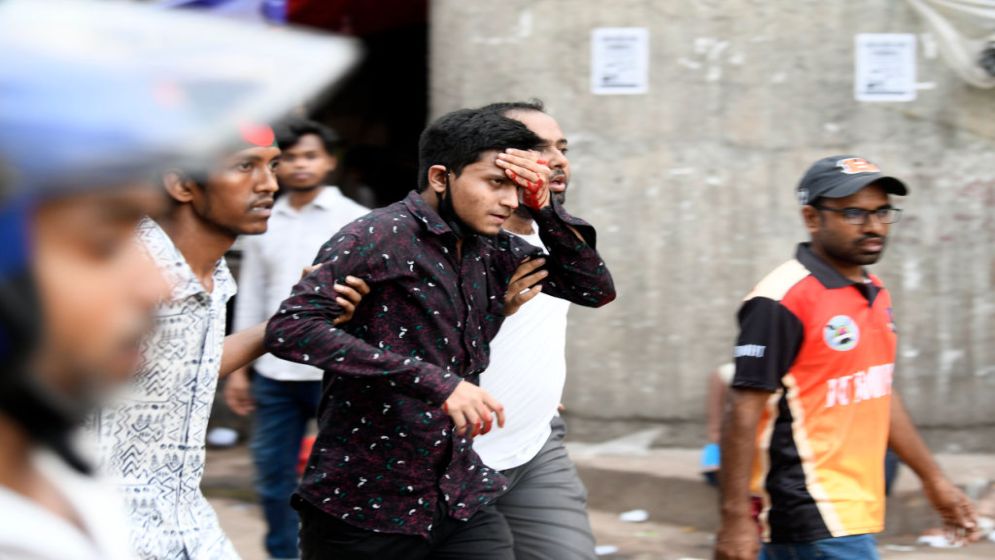Amnesty Report: Further evidence confirms unlawful use of force by police against protesters in Bangladesh

Amnesty International released a second part to its evidence analysis series today, condemning the continued use of unlawful force by Bangladeshi authorities against student protesters during the ongoing quota-reform protests.
The report highlights three incidents of unlawful use of lethal and less lethal weapons by law enforcement agencies, despite the partial restoration of internet access on July 23rd.
Amidst a volatile situation marked by crackdowns, military deployment, curfews, and shoot-on-sight orders, limited information has hindered human rights monitoring. Amnesty International's Crisis Evidence Lab verified videos of the incidents, raising concerns about the protection of protesters' rights.
Deprose Muchena, Senior Director at Amnesty International, expressed alarm over the "grim picture" revealed by the evidence and called on the Bangladeshi government to respect the right to protest, end the violent crackdown, and lift all communication restrictions.
On July 18, videos emerged on social media depicting an incident involving a protester identified as Shykh Aashhabul Yamin, a student at the Military Institute of Science and Technology. He was reportedly injured and later died during clashes with police near a bus station in Savar, near Dhaka, the capital.
In the first video, an Armoured Personnel Carrier (APC) is seen driving along the Dhaka-Aricha Highway with Yamin unconscious on its roof. A subsequent video shows officers attempting to move Yamin's body, with one officer pulling his arms and another his legs, causing Yamin's head to strike the pavement as he falls.
The final video shows officers in riot gear stepping out of the APC, observing Yamin's body on the ground, and later dragging it across road barriers, leaving him beside other officers. The APC eventually departs, leaving Yamin on the road. Reports indicate Yamin succumbed to his injuries later that day.
Amnesty International verified these three videos, noting that none of the twelve officers visible attempted to administer medical aid to Yamin. According to Section 5(c) of the United Nations Basic Principles on the Use of Force and Firearms by Law Enforcement Officials, law enforcement personnel are required to ensure prompt provision of assistance and medical aid to injured individuals.
Derrick Pounder, an independent forensic pathologist who reviewed photographic evidence of Yamin’s injuries, informed Amnesty International that his death was likely caused by birdshot pellet wounds to the left front chest, a method of force Amnesty International deems entirely inappropriate for policing protests.
On July 18, another video surfaced depicting an officer firing tear gas through closed gates at BRAC University in Dhaka, where violent clashes between police and student protesters had erupted. A video captured from within the university shows a group of student protesters gathered on the opposite side of a fenced courtyard, while a Bangladeshi police officer fires tear gas into the crowd through the university gates.
Amnesty International verified these videos, concluding that the actions of the police officer constituted unlawful and unjustifiable use of force. It is emphasized that law enforcement should never deploy tear gas into an enclosed area where individuals have no clear means of escaping the effects of chemical irritants.
According to local news reports, at least 30 people sustained injuries as a result of tear gas use on BRAC University’s campus.
Since July 20, a video clip has been circulating on social media showing an officer firing an AK-pattern assault rifle during protests. Verified by Amnesty International, the seven-second footage was recorded in front of a bank on DIT Road in the Rampura neighborhood of Dhaka.
It depicts several officers from the Bangladesh Police and Border Guard Bangladesh standing near an Armoured Personnel Carrier (APC). One of the officers aims a Chinese Type 56-1 assault rifle off-screen and discharges two rounds.
The use of firearms for crowd control is inappropriate and should only be employed when absolutely necessary to counter an immediate threat of death or serious injury.
In another video, filmed in the Rampura neighborhood around or before July 19, police officers in full riot gear are observed marching alongside an APC equipped with 12-gauge shotguns and 37/38mm grenade launchers. Some officers are seen firing multiple shots from shotguns toward off-screen targets.
Deprose Muchena stated, "Authorities must immediately rescind shoot-on-sight orders, restore nationwide internet access, and cease deploying army and paramilitary forces to manage protests.
They must also ensure that such repressive measures, including shoot-on-sight curfews and internet shutdowns, are never employed again. These actions are clearly aimed at suppressing current and future protests and dissent."
"An independent and impartial investigation into all human rights violations committed by security forces, particularly the significant number of protester deaths, must be promptly conducted. Those responsible must be held fully accountable.
Victims of unlawful police use of force, including the injured and families of those killed, should receive comprehensive reparations from the state."
—-

